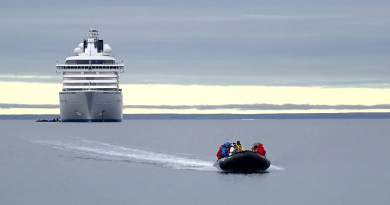Arctic weather satellite leaving Europe for June launch in U.S.

The European Space Agency’s (ESA) Arctic weather satellite is getting ready to leave Europe for its summer launch in the U.S., the organization said on Thursday.
Simonetta Cheli, the ESA’s director of earth observation programs, said that the satellite will enable meteorologists to improve short-term forecasting in the High North.
“This tiny piece of space technology has great potential & an important mission: to supply temperature and humidity data allowing, for the first time, for ‘nowcasting’ in the Arctic,” Cheli said on X, formerly known as Twitter.
Some images from inside @OHB_SE cleanroom where the Arctic Weather satellite is currently stored. This tiny piece of space technology has great potential & an important mission: to supply temperature and humidity data allowing, for the first time, for ‘nowcasting’ in the Arctic. pic.twitter.com/zKEy8cl8Hq
— Simonetta Cheli (@SimonettaCheli) April 4, 2024
Seeing into the North
Satellite imagery is one of the tools that scientists use to predict weather.
The satellites currently used, known as geostationary satellites, are approximately 36,000 above the equator and travel roughly the same speed as the earth’s orbit, but they can’t see far enough North to observe weather patterns in the Arctic.
Meanwhile, the polar-orbiting satellites used for weather and climate monitoring can take up to 24 hours to fully cover the earth, which means meteorologists don’t have access to the real-time data they’d need to make short-term predictions for the Arctic.
The ESA hopes the Arctic weather satellite, a prototype, will be able to help fill in this gap.
Improving predictions, helping climate monitoring
The satellite weighs 120kg with a microwave sounder that’s better able to capture high-resolution humidity and temperature data in all weather conditions and beyond its immediate view, the agency said.
Coming soon to an orbit near you: @esa‘s Arctic Weather Satellite!
The satellite is currently in its very last stages of being checked and readied for shipment by air to California ahead of its launch.
Its enhanced sounding will capture short fluctuations in humidity that can… pic.twitter.com/elFiXKjfPk— ESA Earth Observation (@ESA_EO) April 4, 2024
If all goes as expected, the ESA will launch a cluster of six such satellites, known as EPS-Sterna.
When positioned, the ESA says the satellites will be able to observe 90 per cent of the earth in five hours or less.
“EPS-Sterna is envisaged […]to supply an almost constant stream of temperature and humidity data from every location on Earth,” the ESA said on their website.
“While weather forecasting for the Arctic region is the focus, data from the Arctic Weather Satellite and the potential constellation will also be used to improve weather forecasts around the world and contribute to climate change research.”
The satellite took 36 months to complete and was built by OHB Sweden, a European-based company that specializes in small satellites and satellite subsystems.
The satellite will be launched in California in June.
Comments, tips or story ideas? Contact Eilís at eilis.quinn(at)cbc.ca
Related stories from around the North:
Canada: Meteors, UFOs, space junk? Dawson City residents puzzled by sky sightings, CBC News
Finland: Report recommends creation of Finnish space situational awareness centre, Eye on the Arctic
Sweden: Arctic Sweden—Kiruna pivots from underground to outer space, Blog by Mia Bennett



